Top 7 Canny Alternatives in 2025

Canny has become the go-to feedback management tool for thousands of product teams. It’s clean, it works, and it pioneered many of the features we now consider standard: voting boards, roadmaps, and changelogs all in one place.
But here’s what happens as products grow: what works for one team might not work for another. Maybe you’re a B2C startup watching your monthly bill jump from $79 to $699 as more users engage with your feedback board. Maybe you need features like white labeling or multiple roadmaps that Canny locks behind enterprise pricing. Or maybe you just want something simpler, or more powerful, depending on where you’re at.
What is Canny?
For those new to the space, Canny is a customer feedback management platform that helps product teams collect, organize, and prioritize feature requests. Users can submit ideas, vote on suggestions, and track the status of requests through a public roadmap. It’s become popular because it brings together three key tools: feedback boards, product roadmaps, and changelogs.
Why Teams Are Looking for Canny Alternatives
The most common trigger? That “tracked user” pricing model. It sounds reasonable until you realize that every person who votes, comments, or has feedback submitted on their behalf counts toward your limit. Hit 500 engaged users (pretty standard for a growing SaaS), and you’re looking at $156/month minimum, or $349/month if you need their integrations.
But pricing isn’t the only factor driving teams to explore alternatives:
- Limited free plan: Only 25 tracked users before you have to pay
- Feature gating: Multiple roadmaps, white labeling, and SSO require expensive tiers
- Complexity creep: Some teams find Canny has become bloated with features they don’t need
- Design stagnation: The interface hasn’t evolved much while newer tools offer better UX
- Integration costs: Basic integrations like Slack require the $99/month Pro plan
- No self-hosting option: You’re locked into their cloud platform
Whether you’re feeling the price squeeze, need different features, or just want to see what else is out there, we’ve tested the alternatives. Here are seven tools that give you similar (or better) functionality, many without the surprise bills when your product succeeds.
For a detailed breakdown of Canny’s pricing tiers and hidden costs, see our Canny pricing analysis.
Quick Comparison Table
| Tool | Starting Price | User Limits | Free Plan | Best For |
|---|---|---|---|---|
| UserJot | $29/month | Unlimited | Yes (generous) | Growing SaaS teams |
| Nolt | $29/month | Unlimited | No | Simple feedback needs |
| Sleekplan | $13/month | Pageview-based | Yes | All-in-one platform |
| ProductLift | $18/month | Unlimited | No | Budget-conscious teams |
| Fider | Free (self-host) | Unlimited | Yes | Technical teams |
| Upvoty | $15/month | Unlimited | No | Small teams |
| Usersnap | €39/month | User-based | Trial only | Visual feedback |
1. UserJot: Modern Alternative Built for Growth
UserJot is a feedback, roadmap, and changelog tool built for modern SaaS teams. We focus on making feedback collection simple and keeping pricing predictable as you grow.
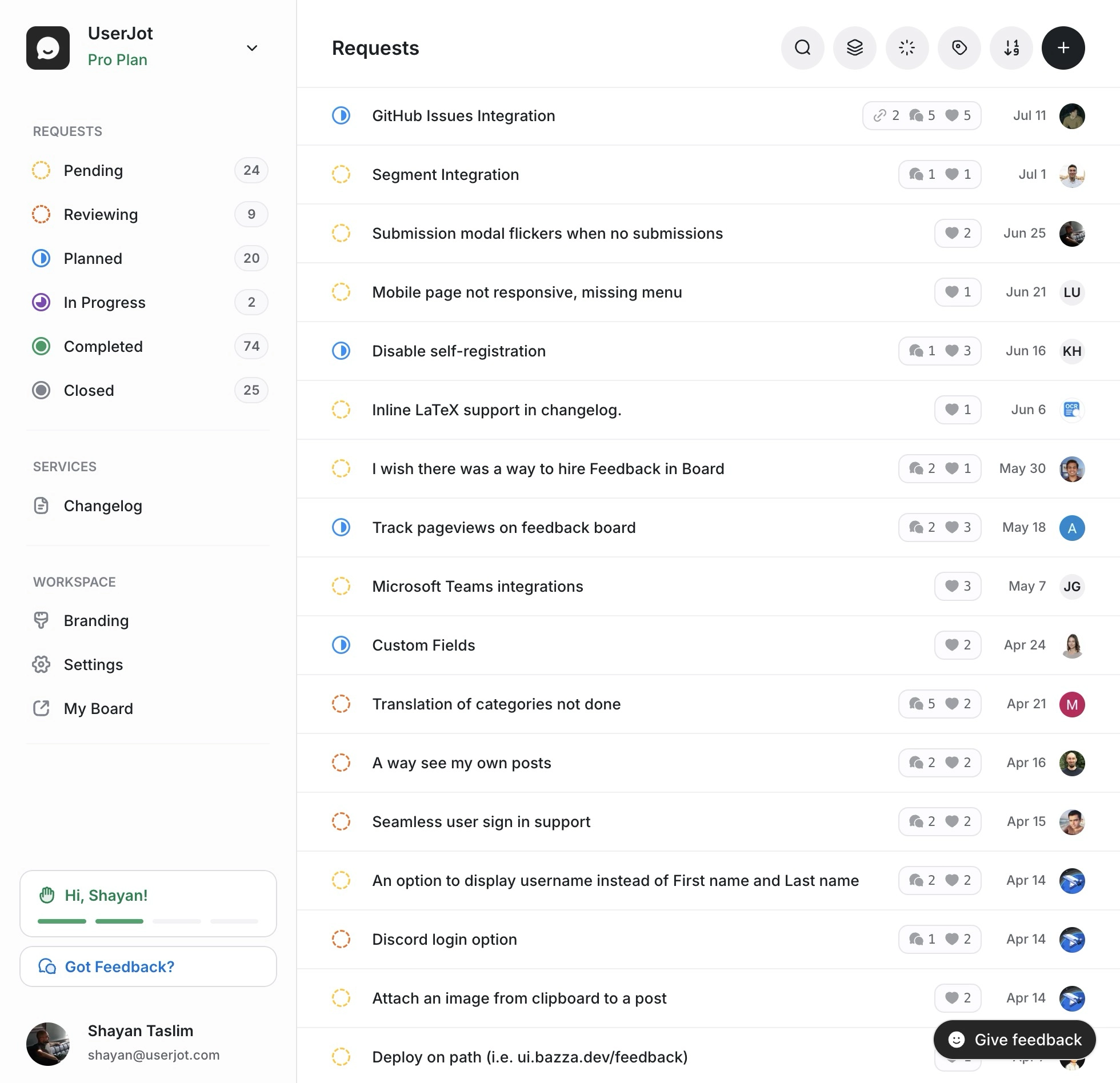
Key Features
- Unlimited users on all plans (including free)
- Multiple feedback boards with voting and commenting
- Public roadmaps with timeline views
- Automated changelog announcements
- JavaScript widget for in-app feedback
- One-click Canny migration tool
- AI-powered duplicate detection
- JWT-based SSO for seamless authentication
Pros
- No user limits ever: Your bill stays the same whether you have 100 or 10,000 users
- Generous free plan: Unlimited posts and users vs Canny’s 25 user limit
- Beautiful design: Clean, modern interface that users actually enjoy using
- Feature-rich lower tiers: Multiple roadmaps and white labeling at affordable prices
- Fast setup: Most teams are collecting feedback within 30 seconds
- Excellent migration: Automated import from Canny preserves all data
Cons
- Newer product: Less established than Canny (launched in 2025)
- Fewer integrations: Still building out integration library
Pricing: Free forever with core features, $29/month Starter, $59/month Professional. No usage-based pricing.
Best for: Teams that want Canny’s features without worrying about user counts. Especially good for B2C products or community-driven SaaS where you want maximum participation. See our detailed Canny alternative comparison.
Stop guessing what to build. Let your users vote.
Try UserJot free2. Nolt: Simple and Predictable
Nolt keeps things simple and predictable. No tracked users, no complex pricing tiers, just straightforward feature-based pricing.
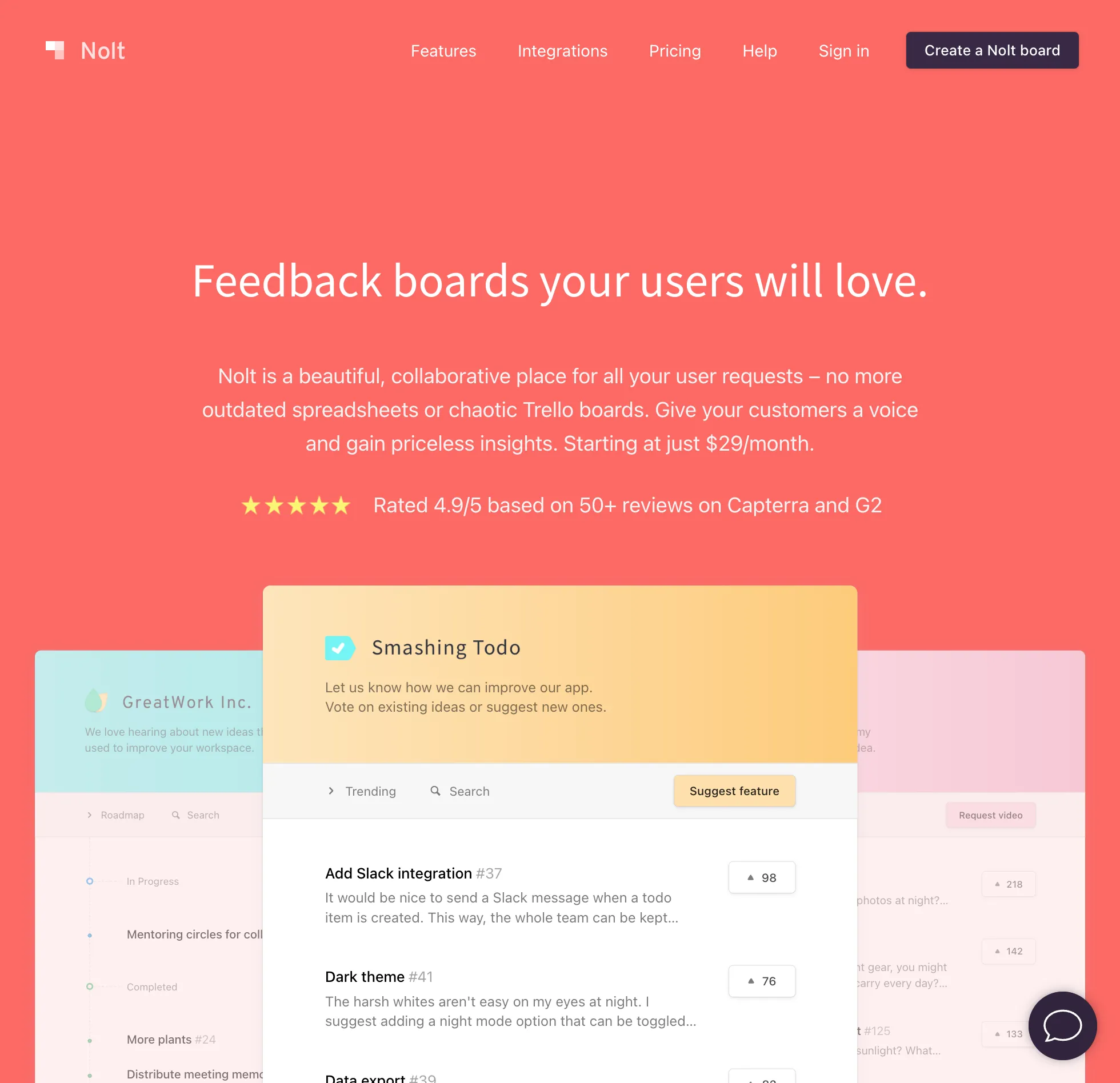
Key Features
- Pay-per-board pricing model
- Clean, minimal interface
- Basic voting and commenting
- Simple roadmap functionality
- Email notifications
- Custom domains
- Basic moderation tools
Pros
- Predictable costs: Pay per board, not per user
- Quick setup: Most teams running in under an hour
- Mobile-friendly: Responsive design that actually works
- No feature bloat: Just the essentials, done well
- Transparent pricing: Know exactly what you’ll pay
Cons
- No free plan: Must pay from day one
- Limited features: No AI, basic analytics, fewer customization options
- Basic roadmaps: Less visual than Canny or UserJot
- Minimal integrations: Only essential connections available
Pricing: $29/month Essential, $69/month Pro. No free plan, but no user-based pricing either.
Best for: Teams that found Canny overly complex and just want clean, simple feedback management without bells and whistles.
3. Sleekplan: The All-in-One Platform
Sleekplan offers more functionality than Canny at a fraction of the price. While Canny focuses on feedback, Sleekplan includes surveys, knowledge base, and satisfaction tracking.
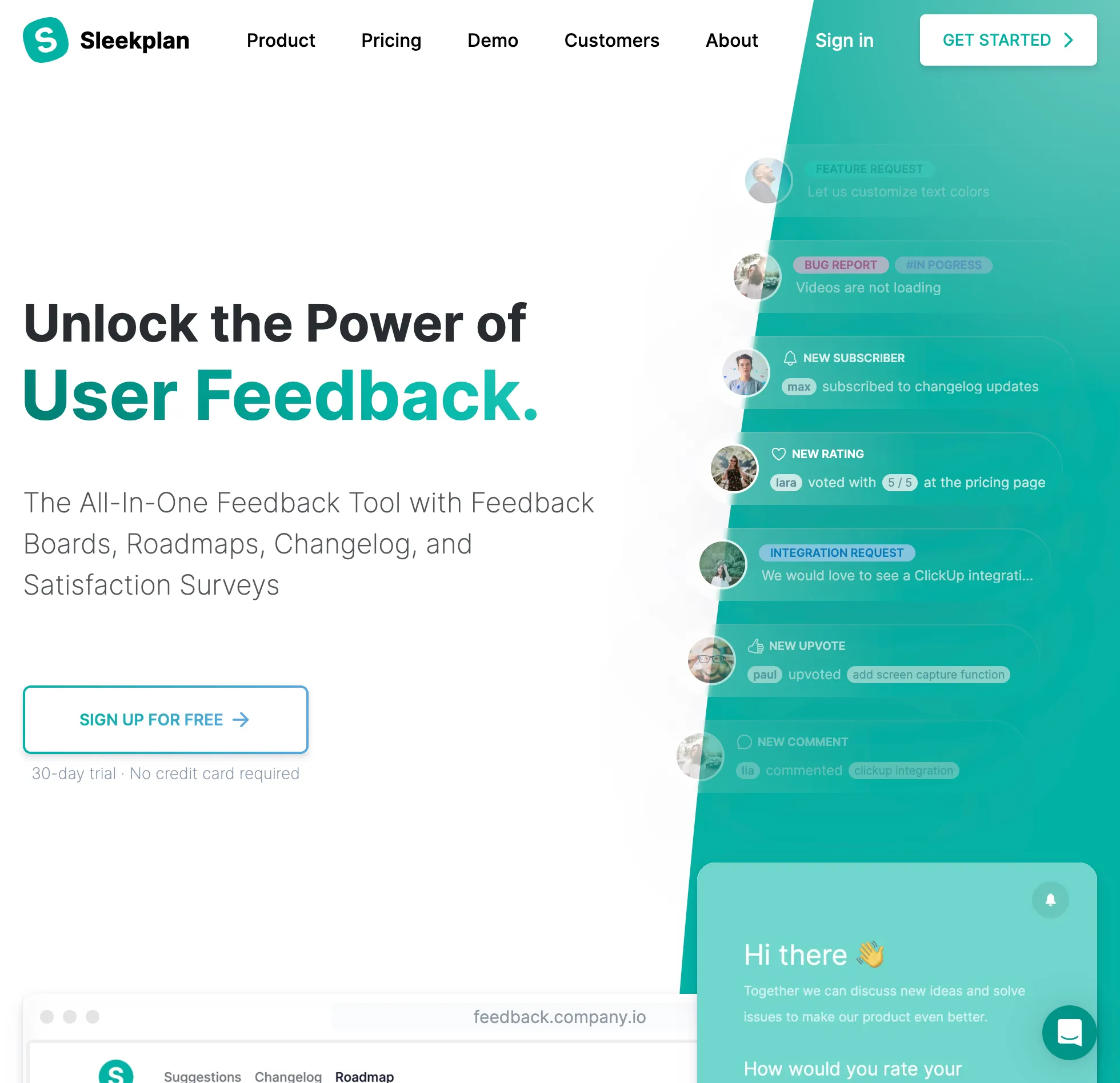
Key Features
- Feedback boards with voting
- Built-in survey tools (NPS, CSAT)
- Knowledge base functionality
- Public roadmap and changelog
- In-app widgets for multiple purposes
- Satisfaction tracking
- Custom CSS styling
Pros
- More features for less: Survey tools and knowledge base included
- Generous free plan: 500K pageviews vs Canny’s 25 users
- Affordable pricing: Full feature set at $38/month
- Multiple tools in one: Reduces need for separate platforms
- Good widget options: Pop-ups, surveys, and announcements
Cons
- Dated interface: UI feels old compared to modern alternatives
- Pageview limits: Can still hit limits with high traffic
- Slower performance: More features mean slower load times
- Learning curve: More complex due to additional features
Pricing: Free plan available, $13/month Starter, $38/month Business.
Best for: Teams that want an all-in-one customer communication platform, not just feedback. Great if you also need surveys and knowledge base.
4. ProductLift: The Hidden Gem
ProductLift flies under the radar but offers exceptional value. The founder personally responds to feedback, shipping features users actually request.
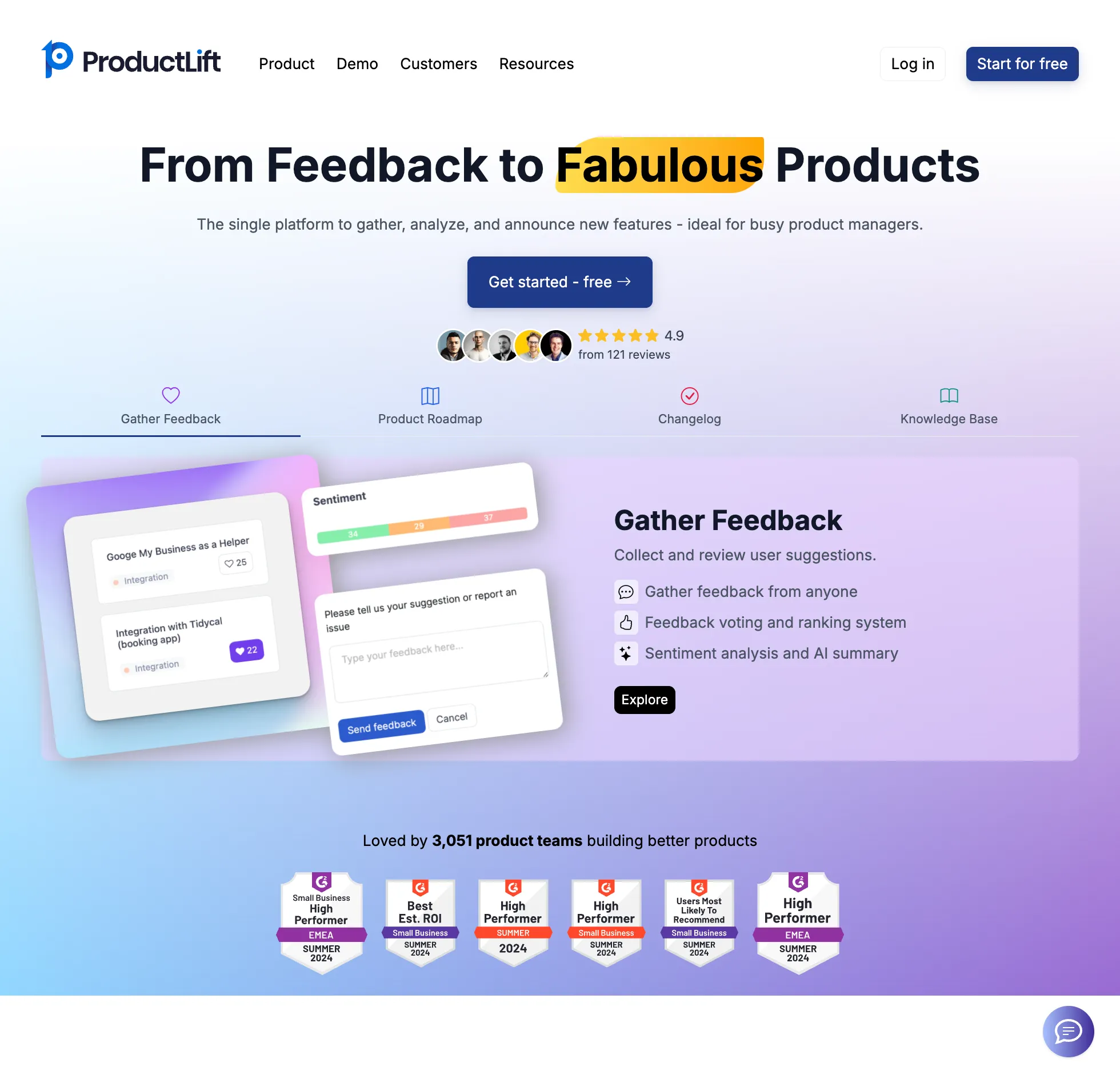
Key Features
- Unlimited users on all plans
- Feedback boards and voting
- Public roadmap
- Changelog with email notifications
- White labeling on lower tiers
- GDPR-compliant infrastructure
- Custom domains
Pros
- Incredible value: Full features starting at $18/month
- No user limits: True unlimited at any price point
- Personal support: Direct access to the founder
- Privacy-focused: European hosting and standards
- White labeling early: Available on cheaper plans than competitors
Cons
- Small team: Slower feature development
- Limited integrations: Basic connections only
- Less polish: Interface not as refined as bigger players
- Unknown brand: Harder to get buy-in from stakeholders
Pricing: $18/month Startup, $49/month Growth, $499/month Scale-up.
Best for: Budget-conscious teams that value responsive support and don’t need every integration. Perfect for bootstrapped startups.
5. Fider: The Open Source Option
If Canny’s pricing has you considering building your own, try Fider first. It’s open source, free to self-host, and covers the basics well.
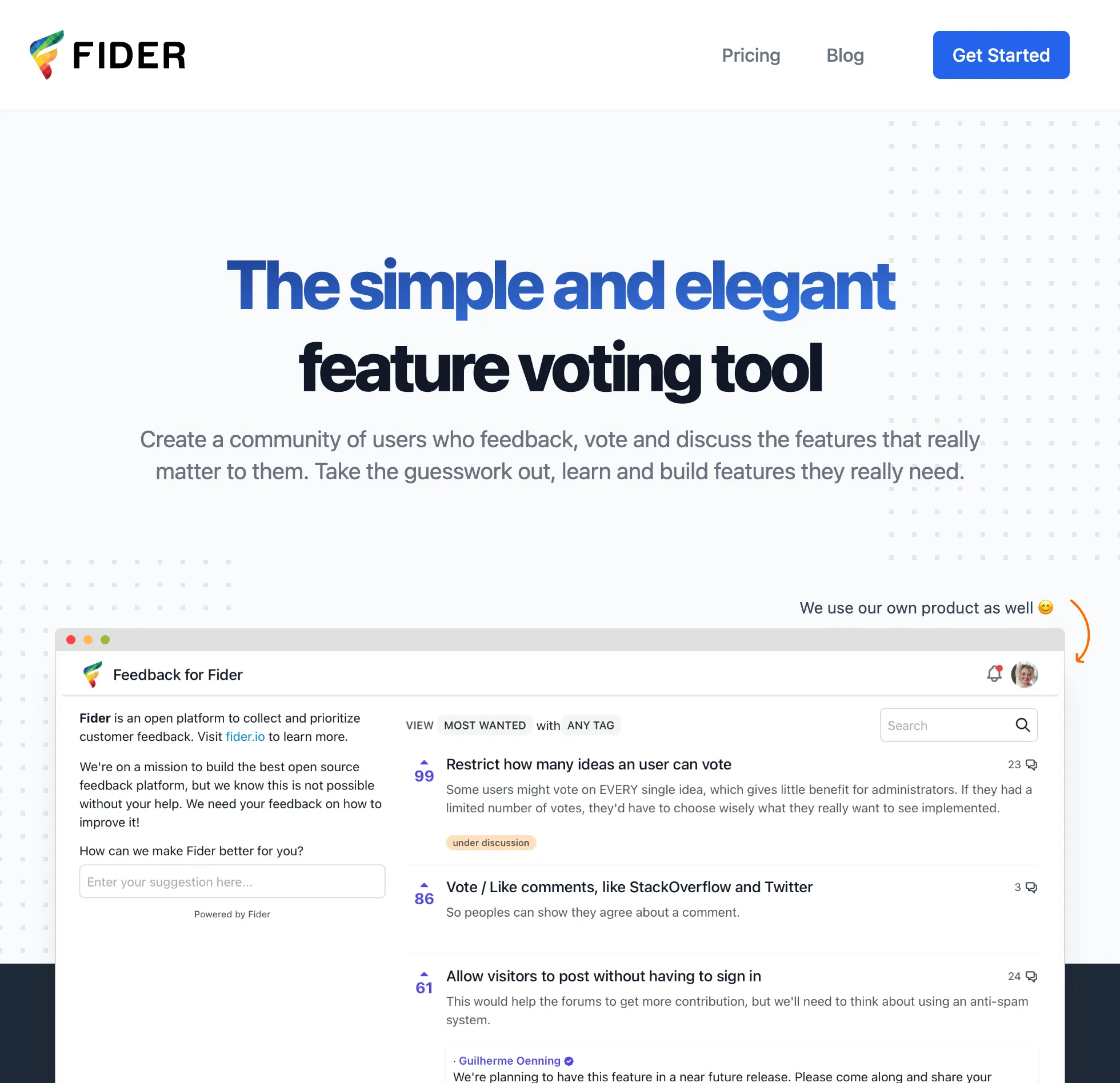
Key Features
- Open source and self-hostable
- Basic feedback boards
- Voting and commenting
- User authentication
- Email notifications
- API access
- Docker deployment ready
Pros
- Completely free: No costs if you self-host
- Full control: Your data, your infrastructure
- No limits: Unlimited everything
- Active community: Regular updates and improvements
- Customizable: Modify the code to your needs
Cons
- No roadmap feature: Missing key Canny functionality
- No changelog: Have to build this separately
- Technical requirement: Need DevOps knowledge
- Maintenance burden: You handle updates and security
- Basic features only: No advanced analytics or AI
Pricing: Free if self-hosted, $49/month for managed hosting.
Best for: Technical teams comfortable with Docker who want to own their feedback infrastructure completely. Not for non-technical teams.
6. Upvoty: No-Nonsense Feedback
Upvoty takes a straightforward approach to feedback. It’s not as feature-rich as Canny, but it’s also not as expensive or complicated.
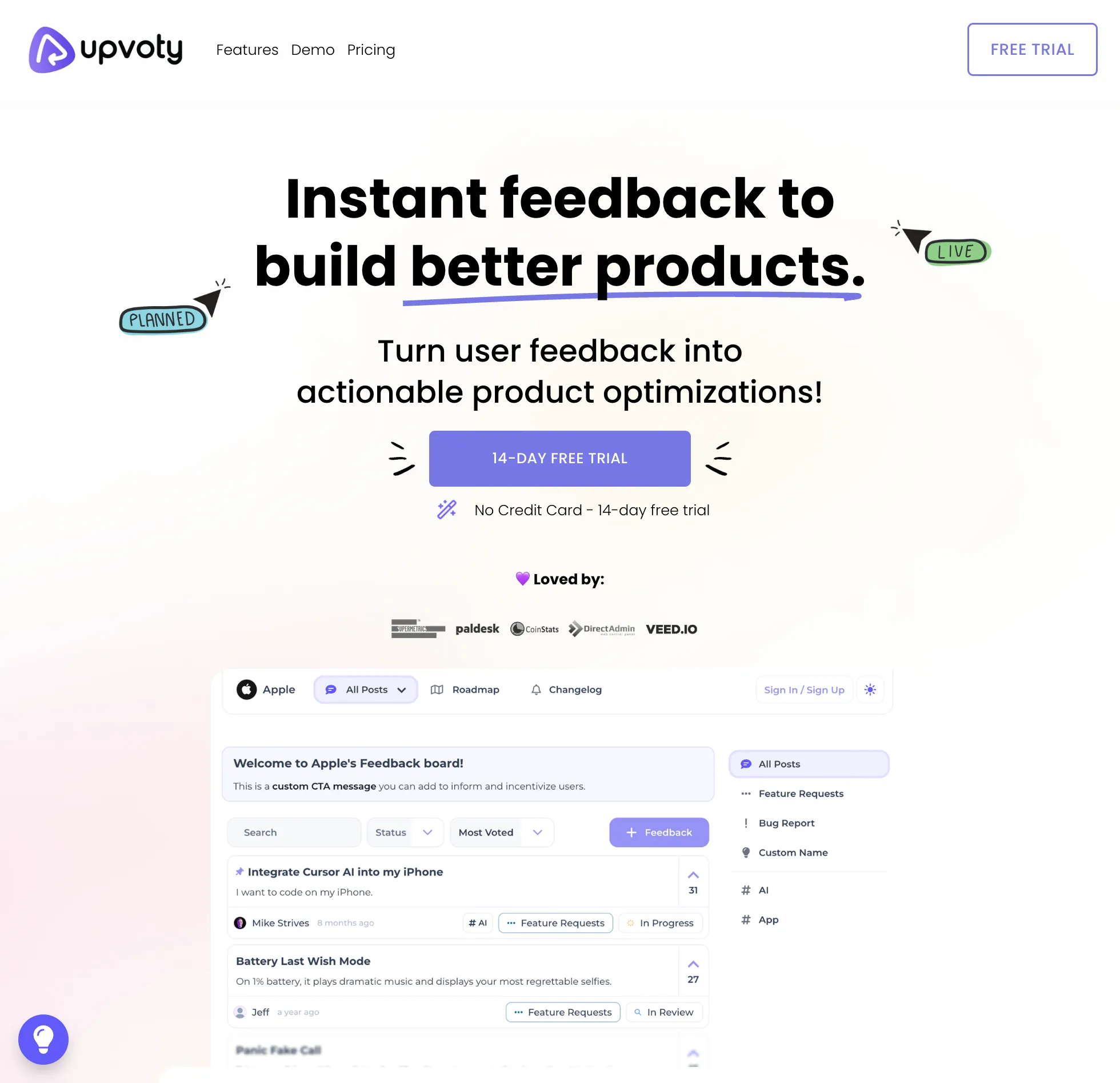
Key Features
- Feedback boards with voting
- Basic roadmap
- Simple changelog
- Status updates
- Email notifications
- Custom domains
- Basic analytics
Pros
- Simple pricing: No user calculations needed
- Affordable entry: $15/month for core features
- Easy setup: Running in minutes
- Clean interface: Uncluttered and straightforward
- No surprises: What you see is what you get
Cons
- Mixed support reviews: Response times vary
- Limited customization: Fewer branding options
- Basic features: Missing advanced functionality
- Weak analytics: Very basic reporting only
Pricing: $15/month Power, $25/month Super, $49/month Hyper.
Best for: Small teams that want something better than a spreadsheet but simpler than Canny. Good starter option.
7. Usersnap: Visual Feedback Specialist
While Canny is text-first, Usersnap excels at visual feedback. Great for teams building visual products or dealing with UI/UX feedback.
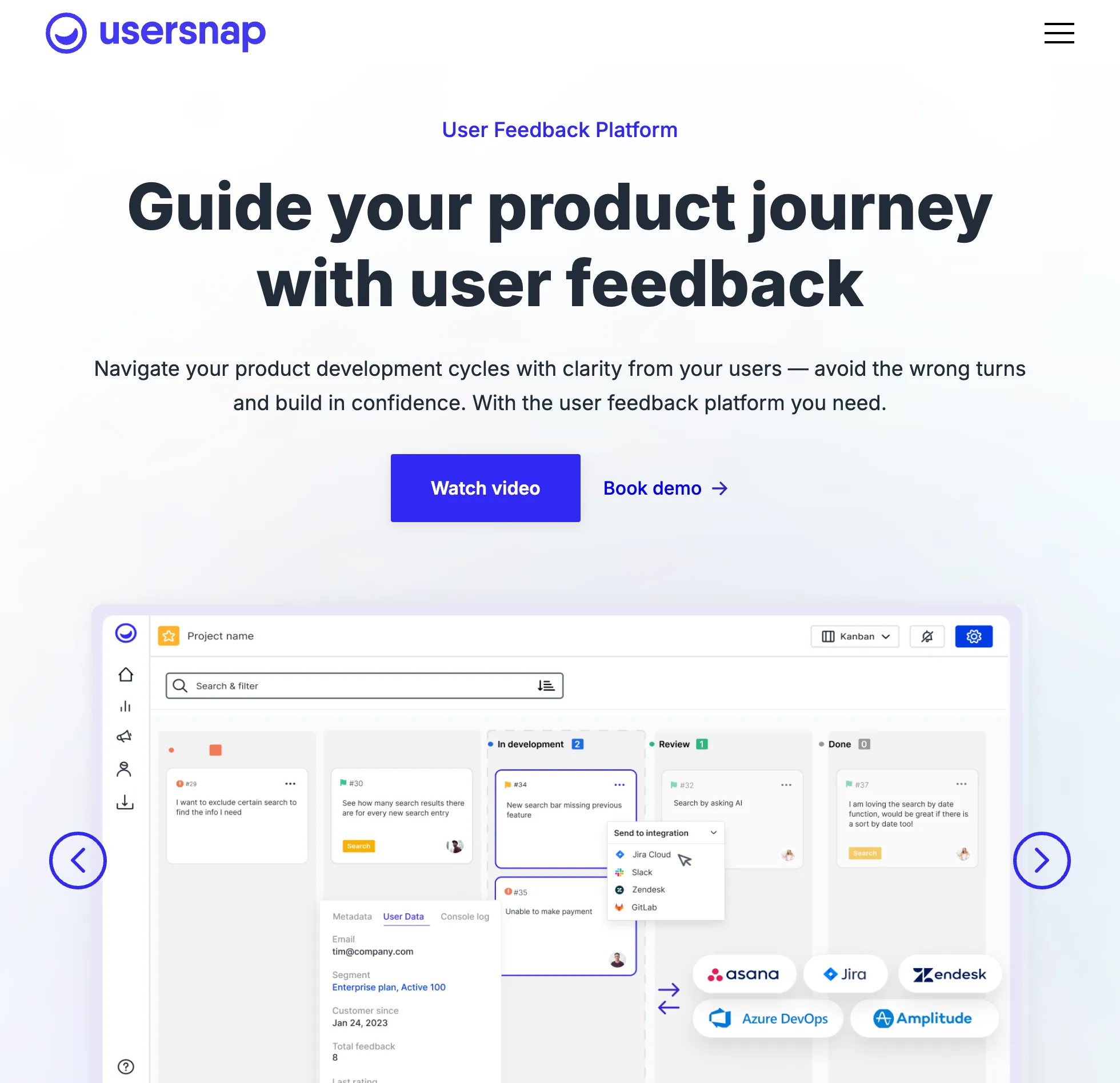
Key Features
- Screenshot annotation tools
- Session replay capabilities
- Browser console capture
- Bug tracking features
- Metadata collection (browser, OS, etc.)
- Integration with dev tools
- Widget and browser extension
Pros
- Visual feedback tools: Screenshot markup and annotation
- Technical data: Captures console logs and browser info
- Session replay: See exactly what users experienced
- Bug tracking: Goes beyond feature requests
- Developer-friendly: Integrates with Jira, GitHub, etc.
Cons
- Expensive: Costs add up quickly with more users
- Weak roadmap features: Not built for product planning
- Complex pricing: Hard to predict costs
- Overkill for simple feedback: Too much for basic needs
Pricing: Starts at €39/month, scales up quickly with users and features.
Best for: Product teams that need visual feedback and bug tracking, not just feature requests. Essential for UI/UX heavy products.
How to Choose the Right Canny Alternative
The best alternative depends on your specific situation. Here’s a decision framework:
Choose by Primary Need
If price is your main concern:
- UserJot for best value with no user limits
- ProductLift for lowest entry price with features
- Fider if you can self-host
If you want simplicity:
- Nolt for cleanest, most focused experience
- Upvoty for basic needs
- UserJot for simple but powerful
If you need more features:
- Sleekplan for surveys and knowledge base
- Usersnap for visual feedback
- UserJot for advanced features at lower tiers
If you want control:
- Fider for complete ownership
- ProductLift for GDPR compliance
- UserJot for data export and migration tools
Choose by Company Size
Startups (1-10 people): UserJot’s free plan or ProductLift’s $18/month plan work perfectly.
Growing teams (10-50 people): UserJot or Sleekplan provide room to grow without surprise costs.
Larger teams (50+ people): UserJot scales without user-based pricing, making it most cost-effective.
Enterprise: Consider staying with Canny or evaluating enterprise plans of alternatives.
Migration Difficulty
- Easiest: UserJot (one-click import)
- Moderate: Sleekplan, Nolt (CSV import)
- Harder: Fider, Upvoty (manual migration)
- Hardest: Usersnap (different focus, manual setup)
Most of these tools offer free trials or generous free plans, so you can test with your actual users before committing. And unlike Canny, you won’t get a surprise bill when your product becomes successful and more users start engaging.
Stop guessing what to build. Let your users vote.
Try UserJot freeFrequently Asked Questions
What makes UserJot the best Canny alternative for growing teams?
UserJot offers unlimited users on all plans (including free), while Canny’s tracked user pricing can quickly escalate from $79 to $699/month as you grow. Plus, UserJot includes features like multiple roadmaps and white labeling on lower tiers that Canny reserves for expensive plans.
Can I migrate from Canny to these alternatives easily?
UserJot offers a one-click migration tool that automatically imports all your Canny boards, posts, votes, and comments. Sleekplan and Nolt support CSV imports. Fider and others require manual migration, which can take more time but is still doable.
Which Canny alternative has the best pricing for small teams?
For small teams, UserJot and ProductLift offer the best value. UserJot’s free plan supports unlimited users (vs Canny’s 25), while ProductLift starts at just $18/month with no user limits. Both are significantly cheaper than Canny’s scaling costs.
Can users submit feedback without creating an account on these tools?
UserJot, Sleekplan, and Nolt all support guest posting without requiring users to create accounts. Canny requires users to at least provide an email address, which can reduce participation rates by 30-40% based on industry studies.
Are there free trials available for these Canny alternatives?
Most offer either free trials or free plans: UserJot has a generous free forever plan, Nolt offers a free trial, ProductLift provides 14 days free, Sleekplan has a free tier, and Fider is completely free if self-hosted.
What’s the main difference between Canny and UserJot?
The biggest difference is pricing structure. Canny charges based on “tracked users” (anyone who votes or comments), while UserJot offers unlimited users at each price tier. UserJot also includes more features on lower tiers like multiple roadmaps and white labeling.
Do these Canny alternatives integrate with Slack and Jira?
Yes, most do. UserJot, Sleekplan, and Upvoty all offer Slack integration. For Jira, UserJot (coming soon), Sleekplan, and Usersnap provide integrations. Canny locks these integrations behind their $99/month Pro plan.
Which tool is best for visual feedback compared to Canny?
Usersnap is the clear winner for visual feedback with built-in screenshot annotation and session replay features. UserJot and Canny focus more on text-based feature requests, though both handle images in posts.
How much can I save by switching from Canny to UserJot?
Teams with 500+ engaged users can save $127-320/month by switching from Canny to UserJot. For example, 500 users on Canny costs $156-349/month, while UserJot’s pricing stays at $29-59/month regardless of user count.
Is UserJot suitable for B2C companies with thousands of users?
Absolutely. UserJot is ideal for B2C companies because there are no user limits. Whether you have 1,000 or 100,000 users giving feedback, your price remains the same. Canny’s model would make this prohibitively expensive.
Which alternative is most similar to Canny in features?
UserJot is the most feature-comparable to Canny, offering feedback boards, roadmaps, changelogs, and similar functionality. The main difference is UserJot’s more modern interface and lack of user-based pricing.
Can I self-host any of these Canny alternatives?
Yes, Fider is fully open source and self-hostable. This gives you complete control over your data and infrastructure, though you’ll need technical expertise to set up and maintain it.